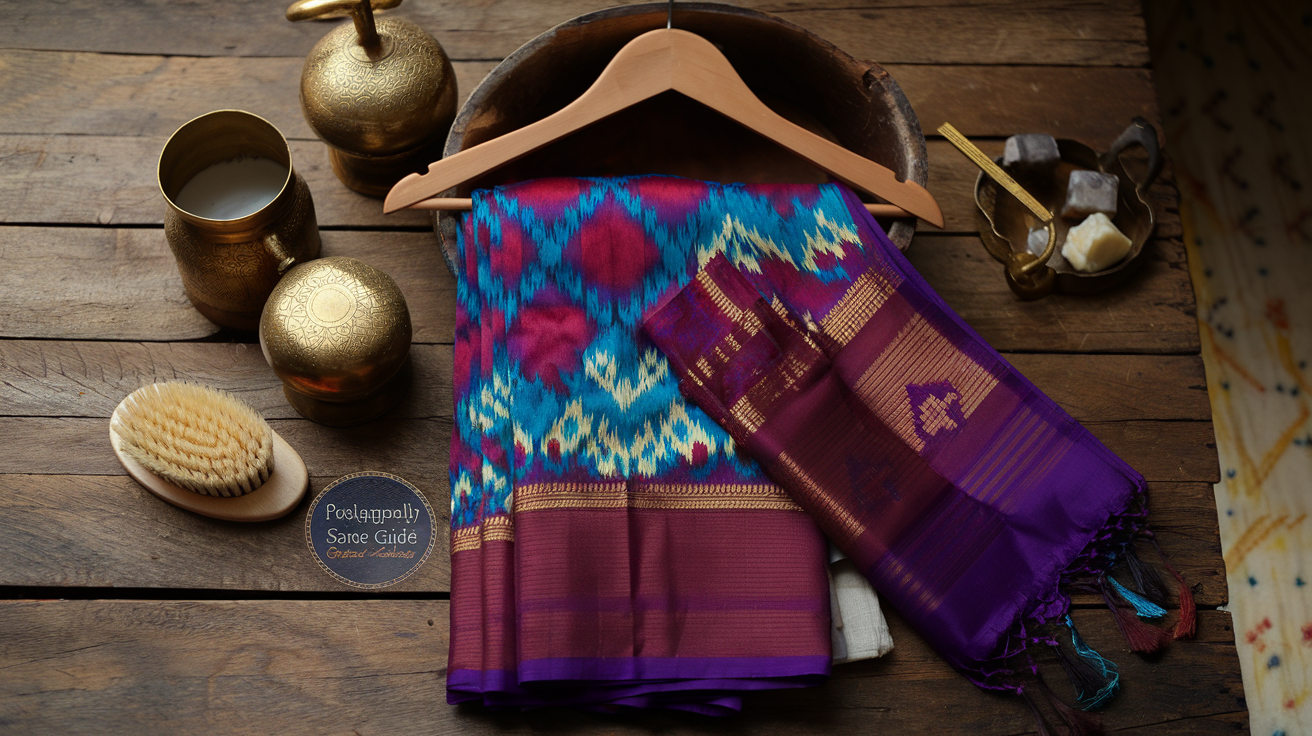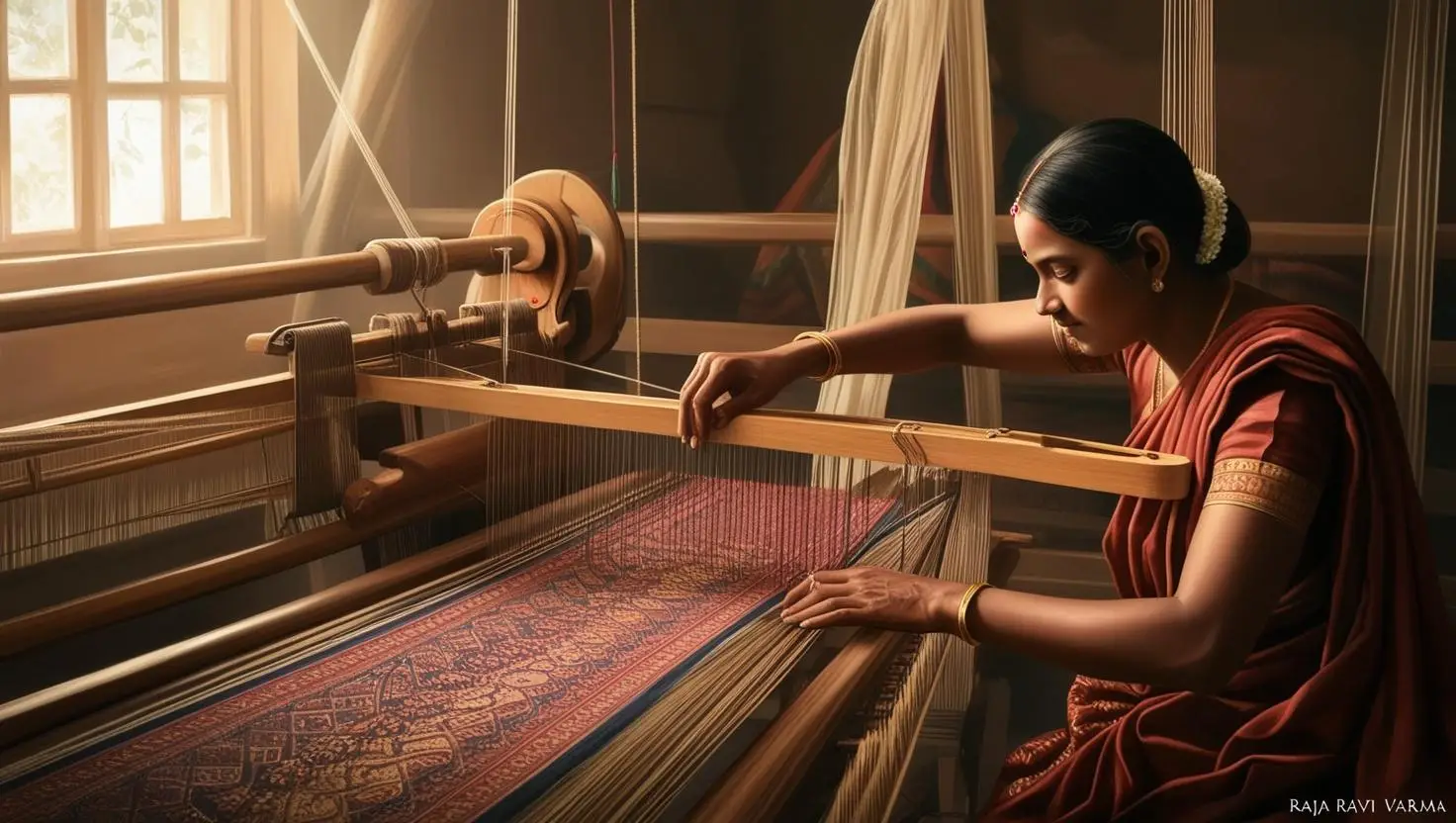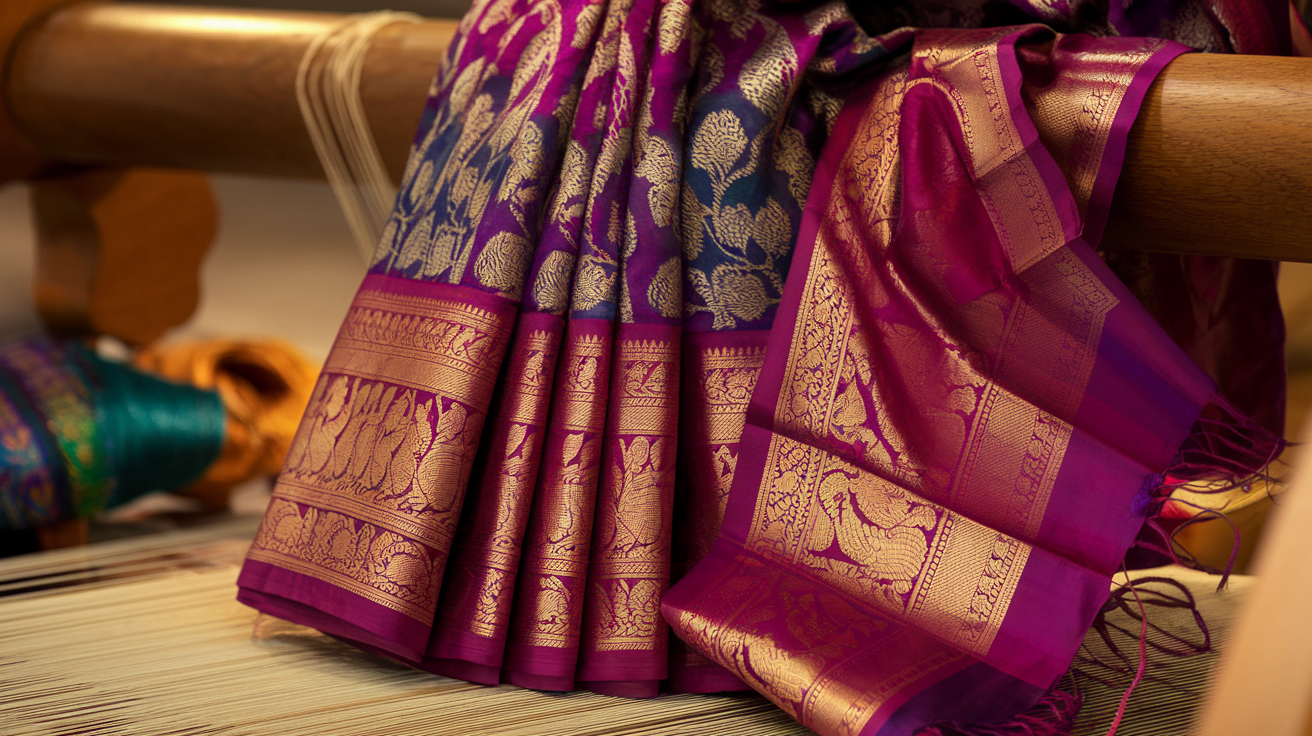The Ultimate Guide to Pochampally Saree Care and Maintenance
Have you ever gazed at your precious Pochampally saree and wondered how to preserve its intricate geometric patterns and vibrant colors for years to come? These treasured pieces—crafted through the meticulous “Paagadu Bandhu” Ikat dyeing technique in Telangana, India—aren’t just garments; they’re living heritage recognized by UNESCO and protected with Geographical Indication status. Yet many saree enthusiasts inadvertently shorten their Pochampally’s lifespan through improper handling and maintenance.
The reality is that each Pochampally saree vibes, whether made from delicate silk or sturdy cotton, requires specialized care tailored to its unique composition. Without proper knowledge, you risk color fading, fabric weakening, and irreversible damage to these artisanal masterpieces that support over 10,000 weaving families. But don’t worry—this comprehensive guide will walk you through everything from essential care guidelines to professional cleaning recommendations, specialized fabric treatments, proper storage techniques, and even restoration methods to keep your Pochampally collection looking magnificent for generations.
Understanding the Rich Heritage of Pochampally Sarees
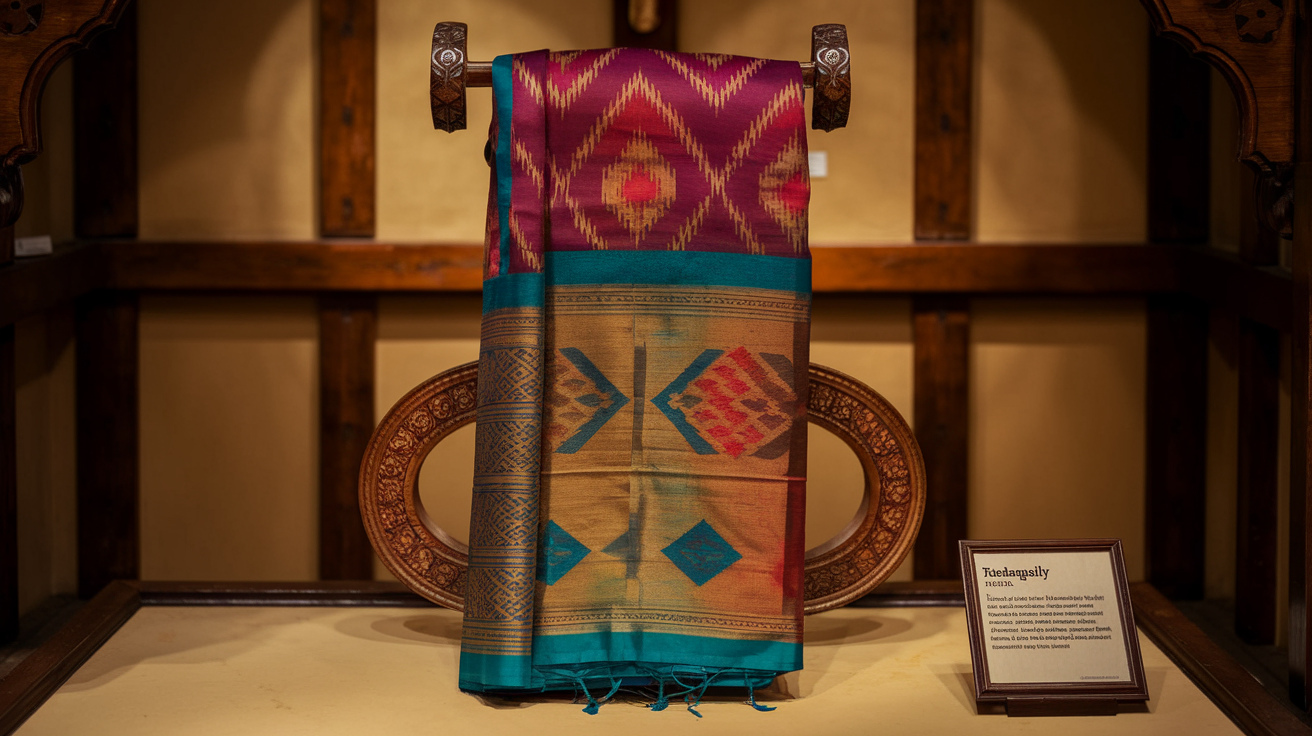
Origin and Cultural Significance in Telangana
The Pochampally saree boasts a rich heritage dating back to the 1950s, when traditional weaving practices were established in Bhoodan Pochampally, located in the Yadadri Bhuvanagiri district of Telangana, India. This region has evolved into a significant textile hub with over 5,000 looms actively producing these distinctive sarees today. The weaving tradition extends beyond just one village, thriving across multiple communities where approximately 10,000 families spanning 100 villages contribute to this cottage industry, generating substantial annual revenue through yarn sales and handloom products.
Pochampally has emerged as one of India’s foremost centers for Ikat weaving, standing alongside renowned regions like Gujarat and Odisha. The cultural importance of these sarees has grown so significantly that the weaving clusters of Pochampally have been included in UNESCO’s tentative list of world heritage sites, recognizing their contribution to India’s textile heritage.
The Iconic “Paagadu Bandhu” Ikat Dyeing Technique
What truly sets Pochampally sarees apart is their intricate “Paagadu Bandhu” Ikat dyeing technique. This meticulous process involves a tie-and-dye method where yarns are carefully dyed before being woven into fabric, resulting in the distinctive geometric patterns known as “chowkra” that have become synonymous with these sarees.
The artisans of Pochampally apply a sophisticated double Ikat technique, where designs are meticulously transferred onto both warp and weft threads prior to weaving. This precision-oriented process creates the characteristic blurred edges in the patterns, giving Pochampally sarees their unique visual identity. While traditional methods remain at the core of production, the introduction of machinery has enhanced weaving precision over the years.
The fabrics produced through this technique are primarily cotton and silk, with an increasing emphasis on natural dyes that preserve the authentic character of these traditional textiles. The Ikat technique practiced in Pochampally can be categorized into three types: Warp Ikat, Weft Ikat, and the most complex Double Ikat, each contributing to the diverse range of patterns available in these sarees.
UNESCO Recognition and Geographical Indication (GI) Status
The exceptional craftsmanship of Pochampally sarees has earned them significant formal recognition. In 2005, the Pochampally saree was granted Geographical Indication (GI) status, a crucial certification that protects its unique identity and supports the livelihood of local artisans. This designation acknowledges the saree’s distinctive characteristics that are inherently linked to its geographical origin in Telangana.
The international recognition of Pochampally continues to grow, as evidenced by its selection as one of the world’s best tourism villages by the United Nations. Furthermore, the Indian government issued a commemorative postal ticket in 2018, highlighting the national importance of this textile tradition.
These recognitions have enhanced the market presence and cultural significance of Pochampally sarees, positioning them as not just garments but as treasured artifacts representing India’s rich textile heritage and the skilled craftsmanship of Telangana’s weaving communities.
Now that we understand the exceptional heritage and craftsmanship behind Pochampally sarees, let’s explore the essential care guidelines that will help preserve these treasured garments for years to come.
Essential Care Guidelines for Your Pochampally Sarees
Having explored the rich heritage and cultural significance of Pochampally sarees with their distinctive geometric patterns and the traditional “Paagadu Bandhu” Ikat dyeing technique, it’s crucial to understand how to properly care for these treasured textiles. The intricate craftsmanship of these GI-protected sarees from Telangana deserves special attention to ensure their longevity and beauty.
Gentle Hand Washing vs. Dry Cleaning: Making the Right Choice
The delicate nature of Pochampally sarees, particularly those crafted using the double Ikat technique, requires careful consideration when choosing a cleaning method. For these handwoven treasures:
- Hand washing is generally recommended for cotton Pochampally sarees, preserving the integrity of the natural fibers and dyes
- Dry cleaning is often the safer choice for silk Pochampally sarees, protecting the delicate silk threads and preventing color bleeding
When hand washing is appropriate, use a gentle motion without wringing or twisting the fabric, as this could damage the meticulously crafted geometric patterns that distinguish Pochampally sarees.
Selecting Appropriate Detergents for Delicate Fabrics
The choice of cleaning agents is critical when caring for Pochampally sarees, especially considering that many artisans are now using natural dyes in their creations:
- Avoid harsh chemical detergents that can damage natural fibers and cause colors to fade
- Select mild, pH-neutral detergents specifically formulated for delicate fabrics
- For sarees with natural dyes, consider using specialized silk or handloom detergents
- Test any cleaning solution on a small, inconspicuous area before treating the entire saree
This careful approach to detergent selection helps preserve the vibrant colors and intricate patterns that make Pochampally sarees distinctive works of art.
Temperature Considerations for Washing and Rinsing
Temperature plays a significant role in maintaining the quality of your Pochampally sarees:
- Cold water washing is highly recommended for both cotton and silk varieties
- Avoid hot water which can cause shrinkage and damage to the delicate fibers
- Rinse thoroughly in cold water to remove all soap residue
- For the final rinse, consider adding a tablespoon of white vinegar to cold water to help set the colors
After washing, never wring or twist the saree. Instead, gently press out excess water and lay flat on a clean white sheet to dry away from direct sunlight, which can fade the beautiful colors achieved through the traditional dyeing processes.
Now that we’ve covered the essential washing and cleaning techniques for your Pochampally sarees, we’ll explore more specialized care approaches based on the specific fabric composition of your treasured pieces, whether they’re made of pure silk, cotton, or a blend of materials.
Specialized Care Based on Fabric Composition
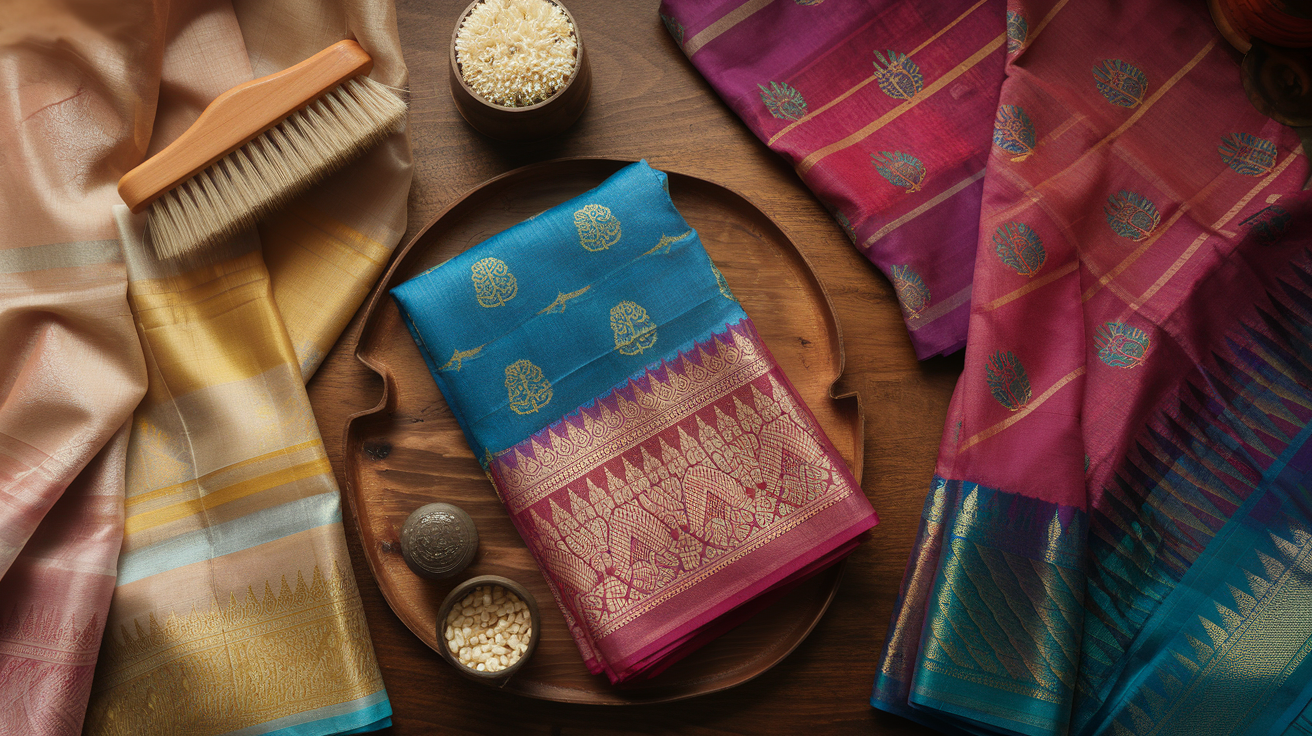
Now that we’ve covered the essential care guidelines for your Pochampally sarees, it’s important to understand that different fabric compositions require specialized maintenance approaches. The unique characteristics of each fabric type demand specific care techniques to maintain their beauty and longevity.
Pure Silk Pochampally Maintenance Techniques
Pure silk Pochampally sarees represent luxury and tradition, with prices ranging from approximately $185 to $441 for premium varieties. These delicate masterpieces require meticulous handling:
- Avoid exposing silk Pochampally sarees to direct sunlight, which can fade their vibrant colors
- Store in muslin cloth or cotton bags to allow the fabric to breathe while protecting from dust
- Hand wash only, using mild silk-specific detergents
- Never wring or twist the fabric; instead, gently press out excess water
- For stubborn stains, consider professional cleaning services rather than attempting home remedies
- After wearing, allow the saree to air out for at least 24 hours before storing to maintain the fabric’s natural sheen
Cotton Pochampally Care Practices
Cotton Pochampally sarees offer breathability and comfort with their distinct ikat patterns. Their care differs significantly from silk varieties:
- Cotton Pochampally sarees can be hand washed or machine washed on a gentle cycle
- Use mild detergents free from bleach or harsh chemicals
- Wash in cold or lukewarm water to prevent color bleeding
- Dry in shade rather than direct sunlight to preserve the vibrant colors
- Iron while slightly damp for best results, using medium heat
- For starch lovers, a light application can help maintain the traditional crisp feel
Cotton-Silk Blend Preservation Methods
The cotton-silk blend Pochampally sarees (often called Pochampally silk cotton) combine the comfort of cotton with silk’s luxury. Priced between ₹4,350 to ₹6,800, these versatile sarees require balanced care:
- Dry cleaning is recommended for regular maintenance to preserve both fabric components
- If hand washing, use cold water and extremely mild detergents
- Never soak for extended periods as this may damage the silk fibers
- Dry flat in shade, away from direct heat sources
- Store by folding with acid-free tissue paper between the folds
- Avoid spraying perfumes or deodorants directly on the fabric as chemicals can weaken the fibers
With proper fabric-specific care, your Pochampally sarees can maintain their beauty for generations. While these home care techniques are essential, sometimes professional intervention becomes necessary. In the next section, we’ll explore professional cleaning recommendations for those situations when specialized expertise is required for your precious Pochampally treasures.
Professional Cleaning Recommendations
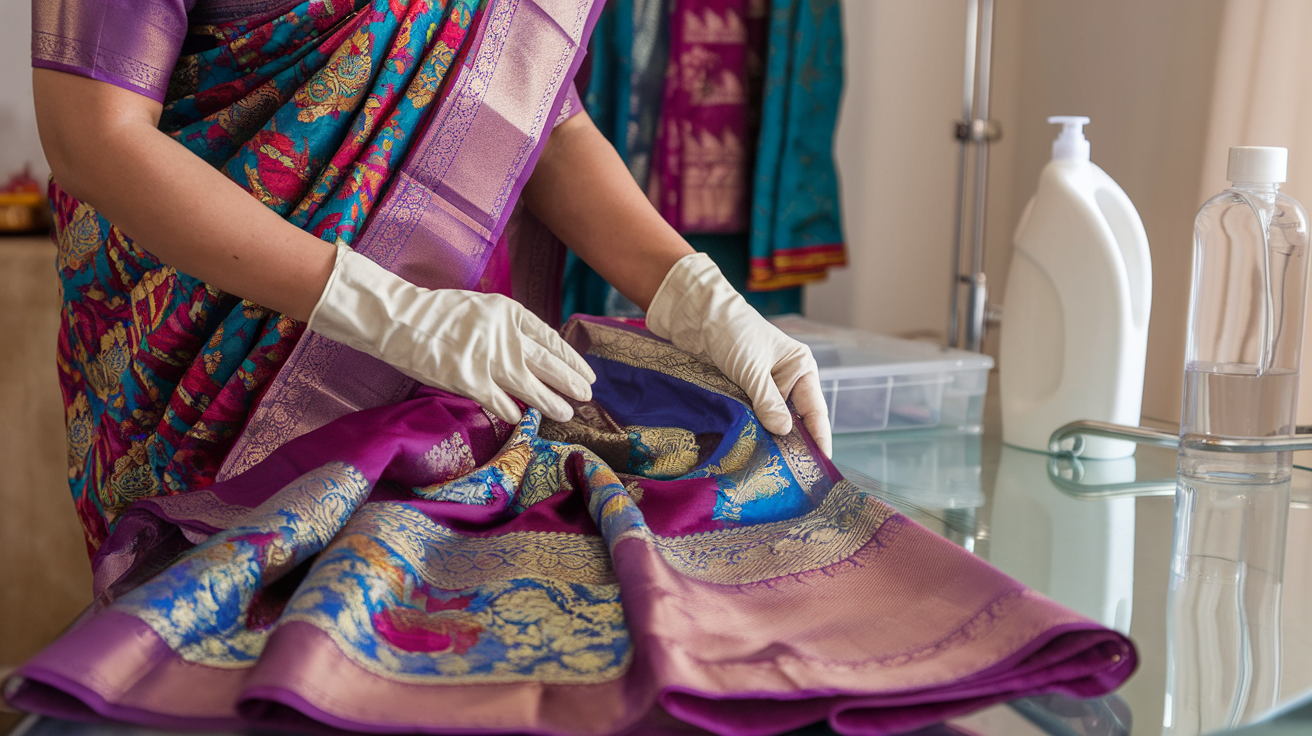
Now that we’ve explored the specialized care needs based on your Pochampally saree’s fabric composition, let’s discuss when and how to seek professional cleaning services. While regular maintenance can be handled at home, there are instances when expert care becomes necessary to preserve the integrity of these cherished handloom treasures.
When to Choose Dry Cleaning for Your Pochampally
Pochampally silk sarees, with their intricate ikat patterns and delicate fibers, often benefit from professional dry cleaning in specific situations:
- When your saree has stubborn stains that home remedies cannot remove
- For occasional deep cleaning to preserve the fabric’s luster and texture
- After prolonged storage, especially if the saree feels stiff or has developed an odor
- For heirloom Pochampally pieces that require extra care
Remember that dry cleaning should be limited to when absolutely necessary. As our examination of fabric composition revealed, frequent dry cleaning exposes your Pochampally saree to chemicals that may gradually affect its natural sheen. Many experts recommend limiting dry cleaning to once or twice a year, with proper airing out after each wear serving as a sufficient maintenance practice between cleanings.
Finding Reliable Cleaners for Traditional Handlooms
Not all dry cleaners are equipped to handle the unique requirements of Pochampally and other handloom sarees. When selecting a professional cleaner:
- Seek specialists with experience in handling traditional Indian textiles, particularly handloom fabrics
- Ask about their familiarity with ikat weaving techniques and Telangana handloom sarees specifically
- Request references or examples of previously cleaned handloom sarees
- Discuss their cleaning methods and ensure they use gentle solvents appropriate for silk
- Always request a roller iron finish rather than machine pressing to maintain the fabric’s texture
Communicate the value of your Pochampally saree to the cleaner, emphasizing its cultural significance and handwoven nature. A reputable cleaner will take extra precautions with such treasured items.
Post-Cleaning Treatments to Maintain Texture
After professional cleaning, additional steps can help maintain your Pochampally saree’s beauty:
- Allow the saree to air completely before storing
- Conduct a visual inspection to ensure no damage occurred during the cleaning process
- For silk Pochampally sarees, gentle ironing at low temperatures can restore the characteristic sheen
- Consider applying a small amount of fabric conditioner specifically formulated for silk if the saree feels stiff
- Test any post-cleaning treatment on a small, inconspicuous area first
Some experts recommend airing out the saree for 24-48 hours after dry cleaning to allow any remaining chemical residues to dissipate completely. This practice helps preserve both the fabric’s integrity and the vibrant colors that make Pochampally sarees so distinctive.
With your Pochampally saree now professionally cleaned and treated, the next crucial step is ensuring proper storage to maintain its beauty and extend its lifespan. In the following section, we’ll explore effective storage techniques that will help preserve your cherished Pochampally sarees for generations to come.
Proper Storage Techniques to Preserve Beauty
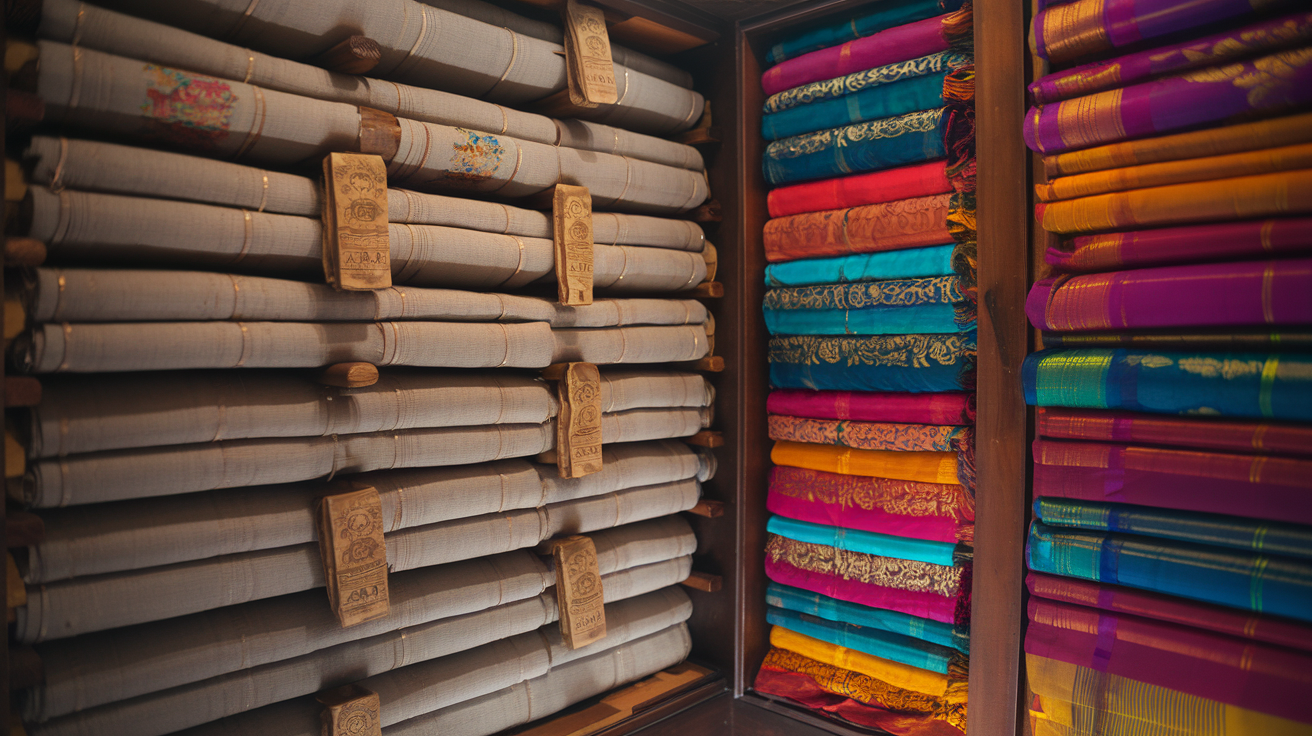
After ensuring your Pochampally sarees are professionally cleaned as recommended, proper storage becomes crucial for maintaining their beauty and extending their lifespan. The artisanal nature of these GI-protected textiles requires special attention to preserve their unique geometric patterns and vibrant colors.
Ideal Folding Methods to Prevent Creasing
Traditional Pochampally sarees, crafted through the intricate “Paagadu Bandhu” Ikat dyeing technique, are susceptible to permanent creasing if stored improperly. To preserve these handwoven treasures:
- Avoid hanging Pochampally silk sarees for extended periods as this stretches the delicate fabric
- Instead of folding in half lengthwise (which creates permanent center creases), fold in a zigzag accordion style
- Rotate the folding points every few months to prevent stress lines in the fabric
- Place acid-free tissue paper between folds to prevent color transfer and minimize friction
- For Ikat cotton sarees, the folding can be slightly looser than their silk counterparts
Humidity and Temperature Control for Long-Term Storage
The 5,000+ looms of Pochampally produce textiles that respond sensitively to environmental conditions. For optimal preservation:
- Store your Pochampally sarees in a cool, dry place away from direct sunlight that could fade the natural dyes increasingly used by artisans
- Maintain humidity levels between 40-50% to prevent mildew growth while avoiding excessive dryness that can make fibers brittle
- Avoid plastic bags which trap moisture; instead, use cotton or muslin storage bags that allow the fabric to breathe
- If storing for very long periods, rewrap and refold every 3-4 months to prevent permanent crease lines
- Consider using silica gel packets in storage areas during monsoon season when humidity levels rise dramatically
Natural Solutions to Prevent Odors and Pests
The traditional craftsmanship of Pochampally sarees, representing the livelihood of approximately 10,000 families across 100 villages, deserves protection from common storage threats:
- Place neem leaves or small pouches of dried lavender between sarees to naturally repel insects
- Cedar blocks or balls provide effective pest protection without harsh chemicals that might damage the artisanal fabrics
- Cloves and bay leaves can be placed in storage containers to prevent musty odors
- Regularly air out your sarees (every 2-3 months) in indirect sunlight to eliminate dampness and refresh the fabric
- For precious silk Pochampally pieces, consider periodic inspection for early signs of pest damage
With these proper storage techniques in place, your Pochampally sarees will maintain their exquisite beauty for years to come. In the next section, we’ll explore effective methods for reviving and restoring Pochampally sarees that may have already suffered damage or fading, ensuring these cultural treasures can be enjoyed for generations.
Reviving and Restoring Pochampally Sarees
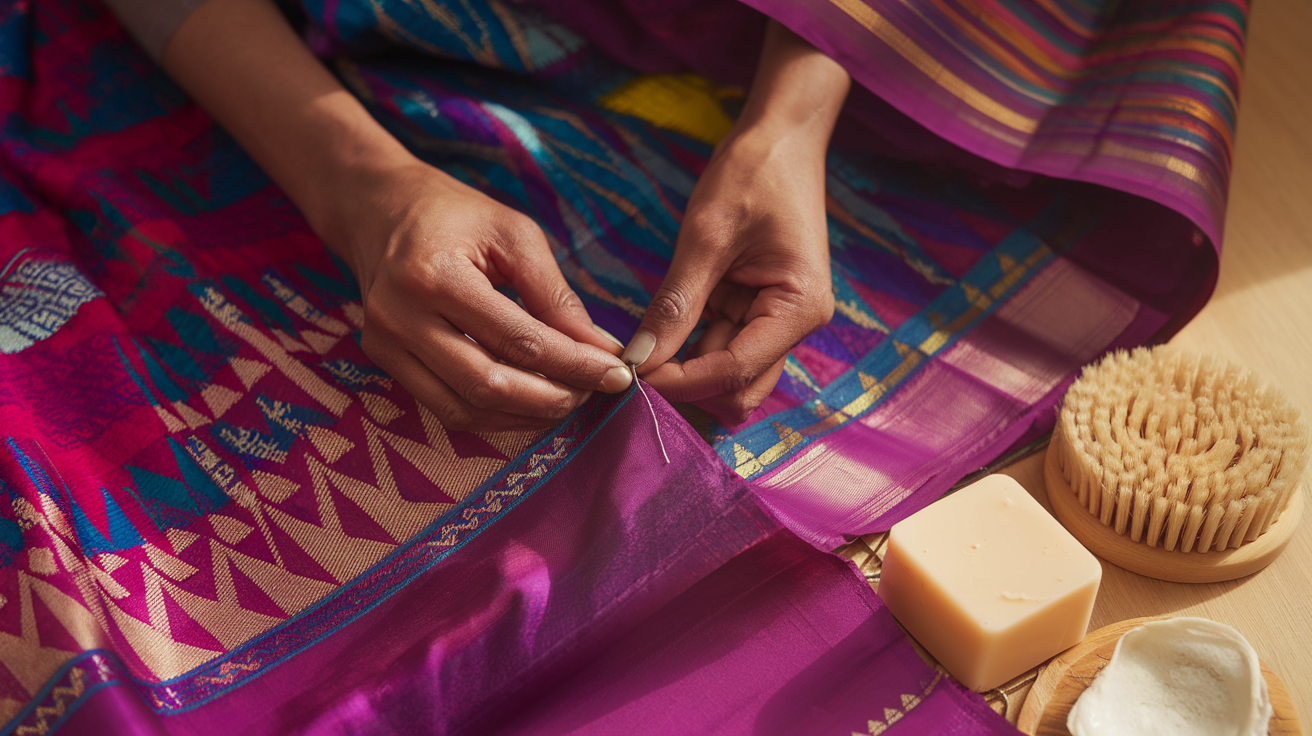
Now that we’ve covered the proper storage techniques to preserve your Pochampally sarees, let’s explore how to revive and restore these treasured handloom pieces when they begin to show signs of age or wear.
Addressing Color Fading and Dullness
Pochampally sarees, known for their vibrant geometric patterns created using the distinctive “Paagadu Bandhu” Ikat dyeing technique, may experience color fading over time. To rejuvenate dull colors in your pochampally ikat saree:
- Consider using natural dyes for touch-ups, similar to those used by the original artisans in the Pochampally weaving community
- For silk Pochampally sarees, a mild vinegar rinse (diluted in water) can help restore some luster to faded areas
- Avoid direct sunlight exposure after restoration, as this can accelerate future fading
- For severely faded heirloom pieces, explore specialized restoration services similar to those offered for traditional textiles
Managing Minor Damages and Loose Threads
The intricate double Ikat technique used in Pochampally sarees creates beautiful patterns but may sometimes result in loose threads or minor damage over time:
- Carefully trim any loose threads with sharp scissors, being cautious not to pull or damage the surrounding weave
- For small tears or fraying edges, consider seeking professional help similar to the heirloom restoration services mentioned in the reference material
- Minor damages to borders can be addressed by carefully transferring or repairing the affected sections
- Document any restoration work done, as this maintains the provenance and story of your traditional pochampally saree
Refreshing Techniques for Vintage Pochampally Pieces
Vintage Pochampally sarees, especially those passed down as family heirlooms, deserve special attention to preserve their cultural and emotional value:
- For cotton Pochampally sarees, gentle hand washing with mild detergent can refresh the fabric without damaging the intricate patterns
- Silk Pochampally pieces may benefit from professional cleaning services that specialize in traditional textiles
- Consider consulting artisans from the Pochampally region who understand the unique aspects of these GI-protected sarees
- For valuable vintage pieces, document the saree’s history and any restoration work, enhancing its significance as both a cultural artifact and personal treasure
Remember that Pochampally sarees represent not just beautiful garments but the livelihood of approximately 10,000 families across 100 villages who maintain this cottage industry. Proper restoration ensures that these textiles, recognized by UNESCO for their cultural significance, continue to be preserved for future generations while honoring the artisanal skills that created them.

Cherishing Your Pochampally Heritage
Throughout this guide, we’ve explored the remarkable journey of the Pochampally saree—from its rich heritage in Telangana’s weaving clusters to the specialized care techniques that preserve its beauty. By understanding the unique “Paagadu Bandhu” Ikat dyeing technique and adjusting your care routine based on fabric composition, you can ensure your precious Pochampally saree vibes remain vibrant for generations. Remember that proper storage, professional cleaning when necessary, and gentle handling are essential investments in maintaining these treasured pieces.
Your Pochampally saree represents more than just elegant attire—it embodies the artistry of 10,000 families across 100 villages who maintain this UNESCO-recognized craft. By following the care guidelines outlined in this guide, you’re not only preserving a beautiful garment but also honoring the cultural legacy of skilled artisans who have perfected their craft over centuries. Treat your Pochampally sarees with the respect they deserve, and they will continue to bring joy and beauty to special occasions for years to come.

